Forum Replies Created
-
AuthorPosts
-
 Robin LeadbeaterParticipant
Robin LeadbeaterParticipantHi Hugh,
Looks good. I identified the coronal lines lines in a 2006 Star Analyser spectrum using this reference
This time round I’ve used ISIS to make a little animated gif (attached) showing the [FeX] line emerging based on 4 observations between 25th Aug and 11th Sept
Cheers
Robin
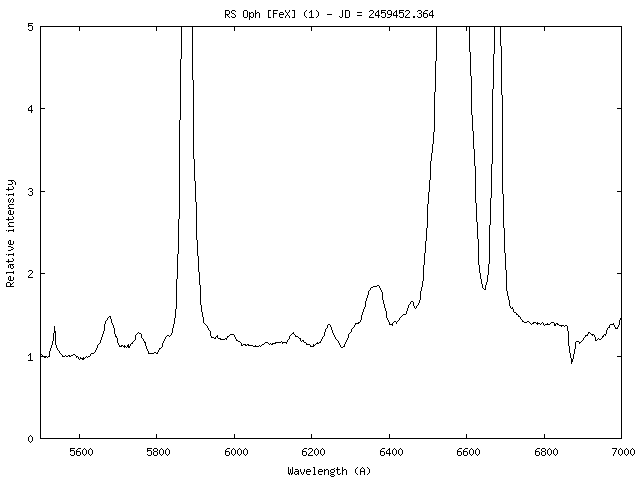
 Robin LeadbeaterParticipant
Robin LeadbeaterParticipantThe legal restrictions have been lifted but the wearing of face masks and social distancing where possible is still advised by both the government and NHS as ways to limit the spread. Personal freedom works both ways. A poll of members would be interesting. It could be that actually more members would attend provided modest precautions like face masks and social distancing were in place than would not attend because they do not wish to follow the guidelines.
 Robin LeadbeaterParticipant
Robin LeadbeaterParticipantThanks Gary.
The Taichi Kato paper was not published until 2004.
https://ui.adsabs.harvard.edu/abs/2004PASJ…56S.135K/abstract
I will send a correction to CDS
Cheers
Robin
 Robin LeadbeaterParticipant
Robin LeadbeaterParticipantHere is the spectrum of BD+25 103, also identified (likely incorrectly) in SIMBAD as Nova And 1979, compared with an F2v standard
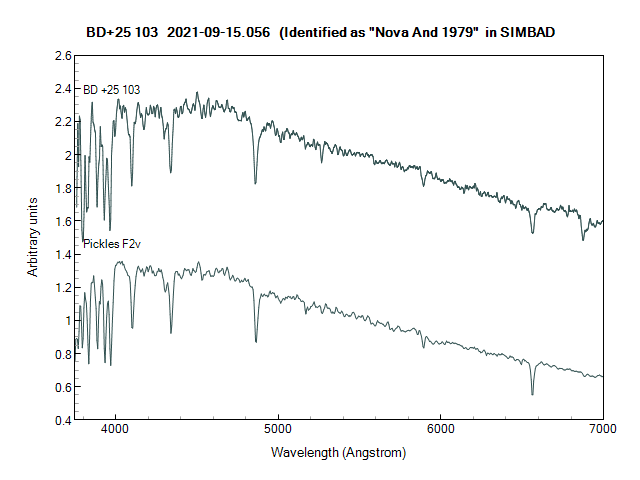
 Robin LeadbeaterParticipant
Robin LeadbeaterParticipantHi Gary,
Could “Nova And 1979” actually have been LL And with a position error? See VSSC #83 1995 p7 and separate thread on “N And 1979”
https://britastro.org/vss/VS0083.pdf
(Your first VSSC after you took over directorship in 1995 by the looks)
Robin
 Robin LeadbeaterParticipant
Robin LeadbeaterParticipantThe TA article
http://articles.adsabs.harvard.edu/pdf/1979Astr…16..152.
confusingly IAUC 3412 covers reports on several diverse objects including asteroid 1979QB
http://www.cbat.eps.harvard.edu/iauc/03400/03401.html
Cheers
Robin
 Robin LeadbeaterParticipant
Robin LeadbeaterParticipantYes that is a a copy of the IAUC with a request for observations. (confusingly that IAUC covers several diverse object discoveries)
“Could the difference be epoch 1950 for the IAU notification as opposed to epoch 2000 for Simbad”
I was comparing with the FK4 (1950) coordinates for the object in SIMBAD
Cheers
Robin
 Robin LeadbeaterParticipant
Robin LeadbeaterParticipantThe answer perhaps lies closer to home !
From VSSC #83 page 7
931207 LL And B.Marsden, CBAT, Paul Wild, Switzerland, Steve
Howell, USA, T.Kato, Japan, Bruce Margon, USA Object reported as a ‘nova’ in IAUC 3412 (1979) seen again in outburst by Tony Vanmunster, Belgium 1993 Dec 7 mag 14.Ov. Confirmed by Poyner. Kato obtains CCD images at Ouda on Dec 9 V=14.0. Suggests position needs correction. Howell obtains spectra and paper planned!
Robin
 Robin LeadbeaterParticipant
Robin LeadbeaterParticipantTracked down the discovery IAUC. Difficult to say without knowing the precision of the coordinates given there but they could be up to ~1 arcmin away from the ones in SIMBAD for this star so not sure yet where the association comes from
 Robin LeadbeaterParticipant
Robin LeadbeaterParticipantA spectrum (R~500)
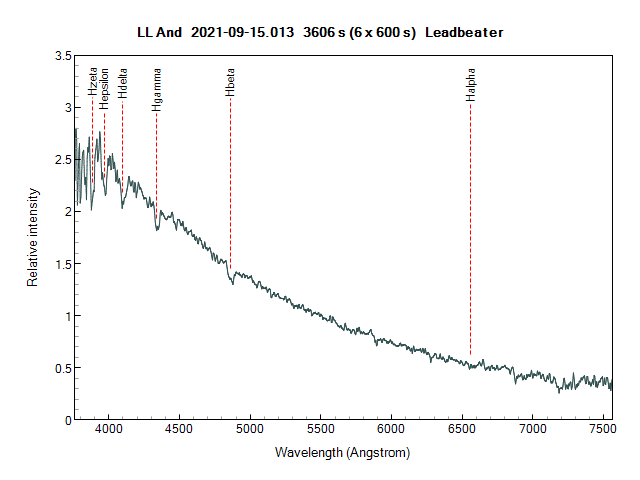
Robin
 Robin LeadbeaterParticipant
Robin LeadbeaterParticipantAh interesting. I see that paper suggested Oxygen might be found as well through the same process. One was found with just O in the spectrum, though by a suggested different mechanism where the He/H is stripped away.
https://physicsworld.com/a/white-dwarf-with-nearly-pure-oxygen-atmosphere-surprises-astronomers/
 Robin LeadbeaterParticipant
Robin LeadbeaterParticipantI see this has now faded to Vmag ~15 so time for perhaps a last low resolution spectrum. It shows a nebula type spectrum with strong forbidden emission lines, particularly [OIII] and a very weak almost undetectable continuum (The Y scale is relative to the continuum at 5500A and the signal/noise in the continuum is down in single figures). In fact I estimate 78% of the light in the V passband comes from just the [OIII] pair of lines at 4959/5007 A
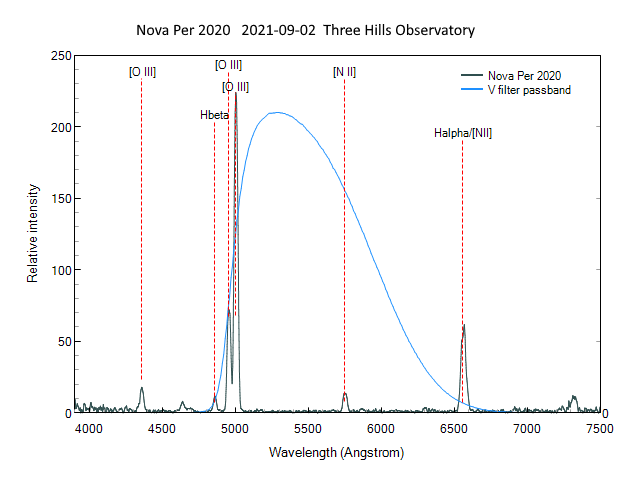
 Robin LeadbeaterParticipant
Robin LeadbeaterParticipantA quick literature search though brought up this reference which talks of WD with initial He atmospheres evolving an H dominated atmosphere through upward diffusion of H.
https://arxiv.org/abs/2008.07469
Anything heavier though I suspect must have been accreted.
 Robin LeadbeaterParticipant
Robin LeadbeaterParticipantI don’t know how it relates to the progenitor but as I understand it, naked electron degenerate white dwarfs don’t show any spectral features and there are indeed some WD like that, designated spectral type DC. The spectral features then come from a thin skin of accreted material, the heavier elements rapidly sinking into the interior to become part of the electron degenerate material so most show just H while others have He or a mix of H/He. You do also find some cool white dwarfs with Carbon in their spectrum, presumably also recently accreted.
 Robin LeadbeaterParticipant
Robin LeadbeaterParticipantAnother interesting WD. No metals or Hydrogen, just Helium
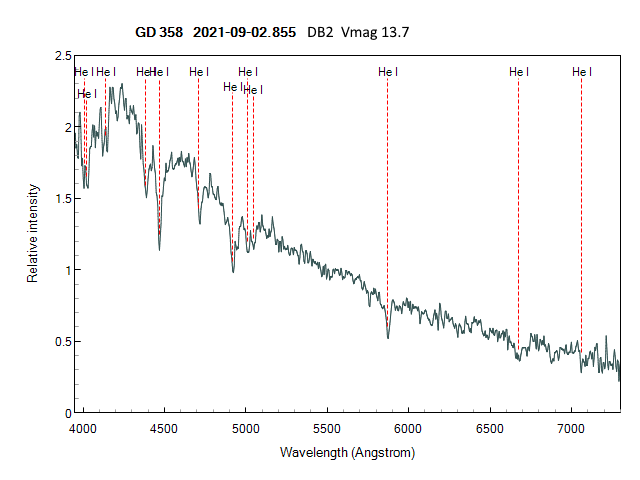
 Robin LeadbeaterParticipant
Robin LeadbeaterParticipantYes it was already clear in 2019 😉
The OI 7774 line is possibly there under the 2nd order but out of focus
 Robin LeadbeaterParticipant
Robin LeadbeaterParticipantNow at mag 16 but still within range of a very low resolution spectrum with the ALPY200.
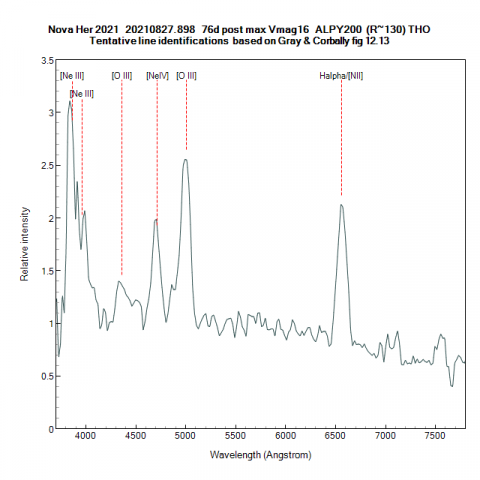
The spectrum with several forbidden nebula lines looks similar to that of another very fast nova Sgr 1991 at similar age in Gray & Corbally , where the tentative line identifications come from
Cheers
Robin
 Robin LeadbeaterParticipant
Robin LeadbeaterParticipant“ (is a 50% increase in effective radius due to pulsations feasible?)”
Though of course a smaller change in radius would be sufficient depending on the path of the hot star behind the M star
 Robin LeadbeaterParticipant
Robin LeadbeaterParticipantYes I agree. If the continuous brightness variations are due to radial pulsations of the M star, these would produce changes in the effective radius (and opacity?) of the M star. These could could asymmetrically shift the mid eclipse point dependent on their timing. (is a 50% increase in effective radius due to pulsations feasible?)
Cheers
Robin
 Robin LeadbeaterParticipant
Robin LeadbeaterParticipantHi Andy,
The measurements pre 1997 were all based on the light curves which are indeed tricky to estimate the mid eclipse point from due to the continuing brightness variability of the red giant throughout the eclipse seen in the AAVSO data in fig 5 of Hugh’s paper. The photometry and spectroscopy were in good agreement within 7 days in 1998 though.
I have extracted B-V from the AAVSO data which is less influenced by brightness variations than using using V I think. I have marked Hugh’s spectroscopic mid eclipse and the expected values based both on the earlier ephemeris and assuming a 60 day increase in period post 1978.
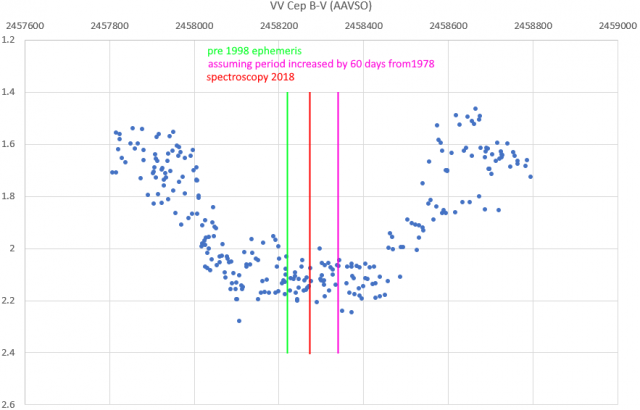
Hugh’s value agrees well with the B-V data. The prediction based on a permanent increase in period is clearly not compatible with the current data but perhaps there is enough wriggle room to say that the original ephemeris is ok and the 1997-1998 eclipse data (both spectroscopic and photometric) was anomalous for some reason?
Cheers
Robin
-
AuthorPosts
